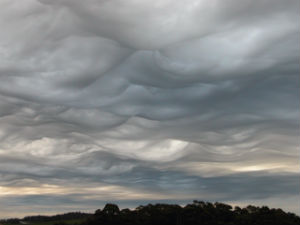Study explains science behind one of the newest recognised clouds
10 May 2017

Citizen science has helped experts to explain how the newly-recognised ‘wave-like’ asperitas cloud is formed.
Scientists at the University of Reading combined infrared satellite images, weather forecasts and laser cloud measurements taken at the time the rare cloud formations were reported by members of the public, to learn about the weather conditions that allow them to form.
Their findings, published in Royal Meteorological Society journal Weather today, show for the first time that asperitas is a low level cloud made of water – not ice as previously suggested - which develops its characteristic from atmospheric disturbances, such as weather fronts and storms.
Professor Giles Harrison, who led an international research team including scientists from the University of Reading’s Meteorology department, the Met Office and the European Centre for Medium Range Weather Forecasting said: “The sky is often full of clues to weather changes, and asperitas provides distinctive visualisation of complex and turbulent air motions in the lower atmosphere.”
“Reading the sky is a key part of meteorological education, warning aviators and those outdoors of potentially hazardous weather. Asperitas is now a cloud to watch out for too.”
Clouds have always appeared in paintings, photographs and pictures, but images captured by amateur photographers confirmed the existence of a dramatic cloud form with a roughened, wavelike base.
This newly-recognised cloud was officially named asperitas by the World Meteorological Organisation in March, following a 10-year campaign for recognition by the UK-based Cloud Appreciation, led by Gavin Pretor-Pinney, a Visiting Fellow in the Department of Meteorology at the University of Reading.
The Reading-led researchers analysing the cloud for the new study compared sightings with available meteorological data from that time and location to investigate the weather conditions that likely gave rise to the cloud formation.
They found that the asperitas formation is likely to be closely associated with atmospheric gravity waves. These are generated along weather fronts and by thunderstorms, where air masses clash and cause vertical motion. This was seen in some of the satellite images analysed by the scientists.
Photo credit: Asperitas cloud over Burnie, Tasmania. Gary McArthur
